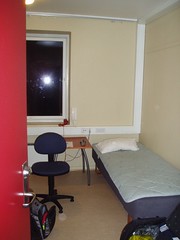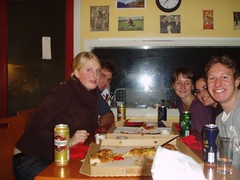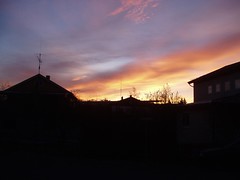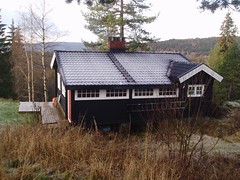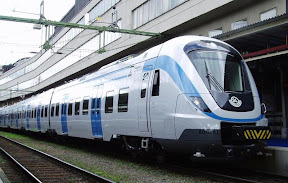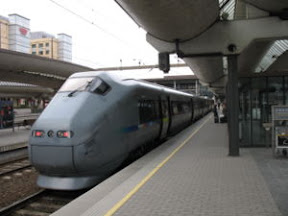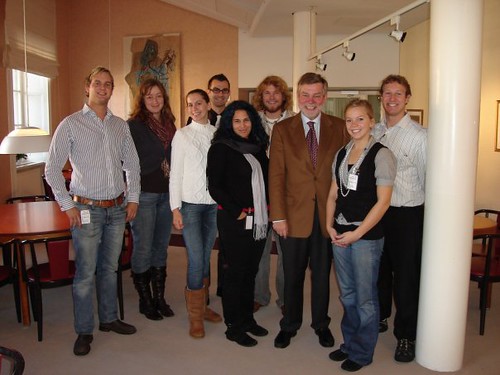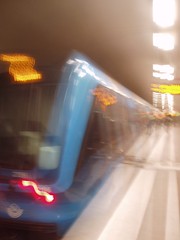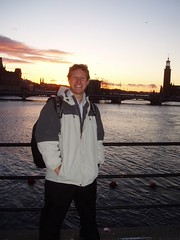Summing up
A Semester in Scandinavia
When I first came to Norway, I knew very little about the country and therefore had few assumptions about what the country was like. Unlike the others in the SUST program who had family connections here, I chose to study in Norway for purely academic reasons. I wanted to have an experience that would deepen my knowledge of urban life as it is experienced in another country. The opportunity to study public transport systems of similar sized metropolitan areas to that of the Twin Cities through the ISP was a major draw.Because I was basically uninformed about Norway, I do not think I have experienced the shock that some of the other SUST participants have experienced. I did not have a strong image of Norway as the: “Land of the Vikings”, with beautiful landscapes, strong environmentalism, tolerance of other backgrounds, openness to all, etc. So, this program has both informed me about these images and crumbled them. The course readings and our guests have revealed growing tensions of xenophobia, consequences created by a constructed national identity, discrimination based on ethnic background, and a growing divide between the wealthy and the poor even with Scandinavia’s Welfare system. I learned that these issues are sometimes considered taboo; subjects that “we don’t talk about here”. By not having a strong perception of what Norway was before coming here, I created the understanding of what Norway is as it was presented to me in the readings and in class discussions.
After reflecting on the semester in general, I realize that I have had very few problems or obstacles that I have had to overcome. In some of our travels I have been thwarted by the airlines in getting to certain destinations (Bergen-Stavanger), yet through patience and perseverance I was able to get to those places eventually and reconnect with the group. In doing research for my ISP, my lack of ability to read Norwegian was an obstacle because important documents were only published in Norwegian with short English summaries. However, I was able to overcome this by contacting and talking to important researchers through my placement at the Norwegian Conservation Society. It made me feel proud to hear positive comments from my program director about my efforts to establish contacts regardless of my lack of experience with the Norwegian language.
Overall I think adapted very well to living in Norway. This can be attributed to the many similarities between Norway and the US in regards to daily life, which I described in my praxis regarding globalization. I was able to buy food that was familiar to me and didn’t have to eat fish eyes or something of the equivalent. My living space at Sogn was similar to that of most student housing developments in the US. I was able to make new friends, something that was a challenge for me. It is easy to rely on family and old friends rather than push myself to meet new people. I hope to stay in contact with my new friends and visit them in the future.
In addition to making new friends, I was able to survive a 4-month separation from my girlfriend who awaits my return. This period provided me with insight into what couples often face in long distance relationships including feelings of jealousy and loneliness, and the arguments that can flare up from the smallest of things. Through this study abroad Kristen and I learned a lot about each other and how we interact with one another when the conversation isn’t face to face.
Finally although I have traveled quite a bit with my family, this was my first trip alone. Before I left on this trip I was worried that things would go wrong and I wouldn't know what to do. I found that even when things go wrong, I can solve the problem. I have survived a traveling here, and the huge ordeal that was, but also arranging other trips in Europe including the trip my Mother and I enjoyed in London during the semester break in October. All of the travel I have done over the past four months has increased my confidence in my ability to solve problems and reduced my fear of traveling on my own.
Through the SUST program I was exposed to a large range of issues facing contemporary Scandinavia including the importance of national identity, immigration and integration, and the future of the welfare state. What I found interesting was how all of these large topics are in themselves interconnected to each other, and how they continue to fuel the center-periphery struggle in Norway, my core issue. I have been particularly fascinated by this debate the entire semester because it relates so closely to things that Minnesota politically is facing in the wake of increased urbanization and centralizing forces. So far this topic has been covered in several sets of critical questions and at least two praxis reflection papers.
In my first praxis paper (Wambach, Praxis 1, 2006) I summarized the work of Knut Heidar (2001) on the creation of Norwegian identity. Heider describes how Norwegian identity was created by social elites who searched for a “pure Norwegian” after gaining independence from Sweden and earlier Denmark. These elites were looking for an identity that was as far from Danish influence as possible. Thus the periphery of Norway, due to the lack of communication technology at the time, along with common Scandinavian ancestry was the perfect place to find the foundation for the fledgling identity. (Wambach, Praxis 1 page 3, 2006). As Szlachetko stated, at the time Norway achieved independence, there were no large urban areas in existence. The relative lack of urbanization, tied with Norway’s geographical conditions, mandated that the regions were more important and self-sustaining out of necessity. The traits that lead to success in a challenging agrarian environment, such as persistence, physical strength, stoicism, and self-sufficiency (or what ever you have read - throw it in here) are still championed in Norway. Yet Norway has developed large urban centers where cooperation, collaboration and tolerance of diverse life styles will be needed to avoid urban problems such as congestion, pollution and disenfranchisement of segments of the population.
Recently this issue has been brought to the forefront for myself with our recent visit with Ketil Solvik-Olsen of the Progress Party of Norway. During that talk I brought up the issue of transportation planning to which he responded quickly and without further discussion that his party favors road investment over investment in critical rail infrastructure. Andrea tried to keep the conversation going by asking whether rail transport would threaten the current decentralized state of Norway, and if favoring roads was a simple form of showing opposition. Though he did not address her question, Andrea was on the right track. In any country there are likely to be forces promoting centralization and those promoting decentralization. Transportation planning is one area of decision-making where those forces become apparent. Like in the US, those in the periphery are often opposed to projects that increase centralizing forces such as investment in High Speed Rail and public transport subsidy. Parties who are in favor of public transportation spending, such as the Social Democrats and to some degree the Conservative party, support these projects due to the benefits of centralization. Hamilton (2004) described how investment in critical infrastructure is often justified because of the creation of economic growth that often occurs as a result of these projects. The economic growth is generated from reduced costs in the movement of people and goods, jobs created while the network is being built, jobs needed to maintain new rolling stock and guideways, etc. However, one could also argue that decentralization can also be encouraged at the same time with these investments because it makes it easier to travel to and from major urban centers of the decentralized state. For example, in the USA planners argue against improving highways, because adding more lanes to roads encourages development further from the urban core called "urban sprawl". Advocates for roads argue that most people prefer to live in more rural or suburban settings and roads allow us to do that, improving our quality of life.
In another praxis I described how classic Scandinavia Literature and art support this stigma against city life. For example, Knut Hamsun’s Growth of the Soil and artwork featured prominently in the National Gallery examine the problems of urban living. Szlachetko commented that the depiction of the urban areas during the early 19th century or height of the industrial revolution often depict the misery of urban life. This is also a common feature in the US art where very strong depictions of the harshness of the urban realm and the need to escape to the peripheries can be found in 19th century literature and art.
Through the process of examining these competing forces in Norwegian culture I have become more aware of how they operate in the USA. For example, our SUST group has discussed the threat to the periphery that Norway’s potential integration with the EU creates through the targeted elimination of subsidies in the fisheries and agricultural sectors (Matlary, 2004). Political parties such as the center party that was formally the agrarian party continue to lobby for these subsidies without addressing the negative effects of continuing these subsidies such as inefficiency and lack of competition. This is similar to Minnesota where lobbyists have called for an increase in the size of feedlots to support increases in livestock production for farmers without considering any of the negative side effects such as environmental degradation through “feedlot” farming practices. I have also come to see how competing forces influence my own personal choices. For example, I believe that using mass transit is better than driving for the environment, but it is sure more convenient to hop in the car. Reconciling the need for preserving the environment with my need to travel when and where I like is a challenge.
To conclude the center-periphery debate for Norway and other states is a dialectical problem. Dialectical problems require us to combine a thesis with its antithesis, or bring together two contradictory ideas, to create a synthesis. Hanging onto core values and traditions of the past while at the same time strengthening these traditions by adapting to changing circumstances is an example of synthesis. Another example is the pursuit of High-Speed Rail to enhance centralization while promoting decentralization at the same time. Seeing problems as either or – we either have or do not have centralization – limits our ability to come up with creative solutions. But dialectical thinking is hard, especially when we are highly committed to our positions. From my vantage point as an outsider, it is easier to see need for synthesis in the problems faced by Norwegians, than it is to see the potential for synthesis in problems we face in the USA, or that I face in my personal life. I hope that as I return to my usual environment, the lessons I have learned through this study abroad experience will help me recognize and think through the dialectical problems I will surely encounter in the future.

